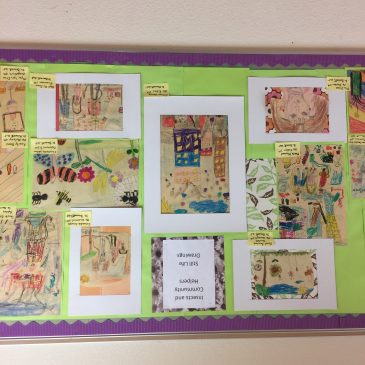One of the most successful arts funded research programs was the arts integrated curriculum model called Picture Writing/Image Making (PW/IM). The rest of today’s blog is given over to quoting from the published report at the RMC RESEARCH CORPORATION of this study:
Picturing Writing/Image-Making Integrated Curriculum Model
“Picturing Writing: Fostering Literacy Through Art and Image-Making Within the Writing Process are two dynamic art-and-literature-based approaches to literacy learning developed by Beth Olshansky at the University of New Hampshire. PW and IM have established histories of proven results in improving student achievement through comprehensive, systematic integration of standards-based art education and standards-based language arts instruction (Frankel, 2011; O’Connor, 2010; Olshansky, 2007, 2008). These innovative, multimodal instructional models have demonstrated their effectiveness in significantly improving student academic performance in writing as well as reading, particularly among at-risk learners, through the integration of standards-based art education into the core curricula.”
https://rmcresearchcorporation.com/portsmouthnh/wp-content/uploads/sites/2/2015/06/PW_FinalReport.pdf
Literacy Through the Arts
“Picturing Writing utilizes a variety of simple crayon resist-based painting techniques within a progression of carefully crafted art-and-literature-based mini-lessons designed to teach essential literacy skills through standards-based art and language arts instruction. Central to the process, students draft their ideas in pictures first. Through analyzing the work of professional artists and writers, learning the grammar and principles of each discipline through the study of quality picture books, and providing students access to quality art materials and instruction, students learn how to create pictures that tell a story and write words that paint pictures. An array of simple texturing techniques (e.g., watercolor and salt, scratching into wet watercolor, splatter painting, sponge painting, plastic wrap prints, and tissue dabbing) allow students to think in more detail and therefore to access more descriptive language when writing to their pictures. Students carefully craft their own quality picture books as they apply the skills they have learned.”
https://rmcresearchcorporation.com/portsmouthnh/wp-content/uploads/sites/2/2015/06/PW_FinalReport.pdf
Visual Tools for Thinking and Learning
“Image-Making utilizes collage made from hand-painted papers created by each student to provide diverse learners with concrete, visual and kinesthetic tools for constructing story. As students literally give shape to their ideas through moving cut-and-torn shapes across each page, they are able to rehearse, draft, and revise their stories long before setting pencil to paper. As they create a sequence of collage images to tell their story, students are able to orally rehearse their story-line through reading their pictures. These dynamic models represent a major paradigm shift. They recognize that traditional straight verbal instructional methods used in classrooms across the nation are failing to meet the needs of our diverse learners and that many students who struggle with reading and writing are visual learners. PW/IM offer students a variety of visual tools for thinking and learning, thus eliminating the hidden bias within our schools that favors the verbal learner. Facilitated within an “Artists/Writers Workshop” format, the PW/IM models treat words and pictures as complementary, parallel, and equal languages for learning. They provide diverse learners with concrete visual tools for developing and expressing their ideas throughout the writing process. Within Artists/Writers Workshop, daily lessons are facilitated in two complementary strands: an art strand, which focuses on the language of pictures, and a writing strand, which focuses on the language of words. The art strand always precedes the writing strand. Whether focusing on pictures or words, each lesson follows the same four-step format.”
Artists/Writers Workshop
https://rmcresearchcorporation.com/portsmouthnh/wp-content/uploads/sites/2/2015/06/PW_FinalReport.pdf
• Literature Share/Discussion
• Modeling
• Work Session
• Group Share
Standards Aligned
“Through the use of quality picture books as mentor texts and the interweaving of literature-based art and writing lessons, PW and IM have demonstrated their ability to reach a wide range of learners. While aligned with English language arts and art standards, these art-infused models can be easily integrated across the curriculum. As students engage in creating their own high quality, content-driven picture books, PW and IM provide a highly structured, enticing, alternative pathway into the reading/writing process that has proven to be an effective intervention, particularly for those who struggle with words. These comprehensive models are also aligned with many best practices including brain-based learning, differentiated instruction, project-based learning, self-efficacy theory, multimodal instruction, theory of multiple intelligences, and the zone of proximal development. Twenty-First Century Skills (the 4’Cs: critical thinking, creativity, collaboration, and communication) are naturally woven throughout each process.”
https://rmcresearchcorporation.com/portsmouthnh/wp-content/uploads/sites/2/2015/06/PW_FinalReport.pdf
Transmediation
“PW/IM also offer students the opportunity to experience the phenomenon of transmediation (the recasting or translating of meaning from one sign system to another) known to deepen students’ thinking, generate new ideas, and create greater opportunities for reflection (Siegel, 1995). As students make meaning in pictures first and then translate that meaning into words, they are not only drawn more deeply into their picture, but also experience the image “as if they were there.” As they access descriptive language to describe what is happening in their picture, they experience their picture “come alive.”
https://rmcresearchcorporation.com/portsmouthnh/wp-content/uploads/sites/2/2015/06/PW_FinalReport.pdf
References
- Frankel, S., Olshansky, B., & Yang, J. (2015). Picturing Writing/Image-Making Integrated Curriculum Model: Evaluation of an Alternative Art-and-Literature-Based Approach to Literacy Learning. Portsmouth, NH: RMC Research Corporation.
Authors’ Affiliation
- Susan L. Frankel, Ph.D., RMC Research Corporation
- Beth Olshansky, Center for the Advancement of Art-Based Literacy, University of New
Hampshire. - Jiaxiu Yang, Ph.D., RMC Research Corporation




